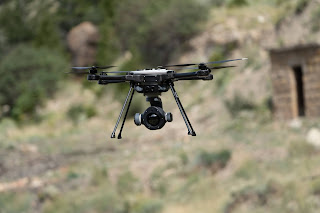Next-Generation Line of UAS Payloads Delivers
High-Performance, Multi-Sensor Capabilities for ISR, Event Overwatch, Search
and Rescue, and Force Protection Missions
ARLINGTON, Va., November 19, 2019 ― FLIR
Systems, Inc. (NASDAQ: FLIR) announced today the FLIR StormCaster™ family of
Unmanned Aerial System (UAS) payloads for its SkyRanger® R70
and R80D SkyRaider® airframes. The new line launches with two
multi-sensor products –StormCaster-T, which delivers continuous zoom and
longwave infrared (LWIR) imaging; and StormCaster-L, which provides
ultra-low-light imaging, tracking, and mapping.
StormCaster represents FLIR Systems’ next generation payload
family for the company’s own UAS airframes gained through the acquisition of
Aeryon Labs in February 2019. The new line reflects a leap forward in scalable
performance, offering a 7X improvement in line-of-sight stabilization, enhanced
range of motion, and greater geolocation accuracy – all in a rugged package.
Interoperability across the StormCaster family enables users to quickly and
easily change modules on the FLIR SkyRanger and SkyRaider UAS systems. The
StormCaster line will leverage continuing improvements in aircraft performance,
providing small units with the organic capability to conduct increasingly
demanding missions such as intelligence, surveillance, and reconnaissance (ISR).
“StormCaster-L and –T are just the beginning of this new
line of advanced, high-performance payloads for our small, tactical UAS
platforms,” said David Ray, president of the Government and Defense Business
Unit at FLIR. “For mission needs ranging from force protection and border
security to clandestine operations, FLIR StormCaster will provide heightened
situational awareness, bolstered by our aircraft’s onboard, real-time
artificial intelligence.
“We will develop more multi-sensor payloads through 2020
that deliver on our promise to offer capabilities at the individual operator
level that previously required larger, more expensive UAS,” Ray added.
The StormCaster-T features a FLIR Boson thermal camera to
support detection, recognition, identification, and target acquisition day or
night, with maximum range and time-on-station. Its continuous zoom lens, with a
75-millimeter maximum focal length, permits long distance ISR while providing
clear, actionable imagery. The StormCaster-L ultra-low-light imaging camera
offers superior ISR and mapping performance during twilight and nighttime
operations. Key features include 4K recorded video and full-color night vision
in low-light conditions.
Developed for United States (U.S.) defense and federal
agencies, the R80D SkyRaider delivers a range of versatile Group 2 and 3
payload capabilities with the agility and single-operator deployment footprint
of a proven Group 1 Vertical Take-Off and Landing (VTOL) aircraft. SkyRaider
can carry and deliver multiple payloads up to 4.4 pounds and features an open
architecture, plus one of the most powerful embedded AI computing devices
available on a sUAS. Similar in capabilities to the R80D but for non-U.S.
military customers, the SkyRanger R70 was designed for the most demanding UAS
operators within the global defense, security, and public safety markets.
The new StormCaster payloads are available for purchase
today. For more on FLIR StormCaster offerings, visit www.flir.com/StormCaster-L and www.flir.com/StormCaster-T.





